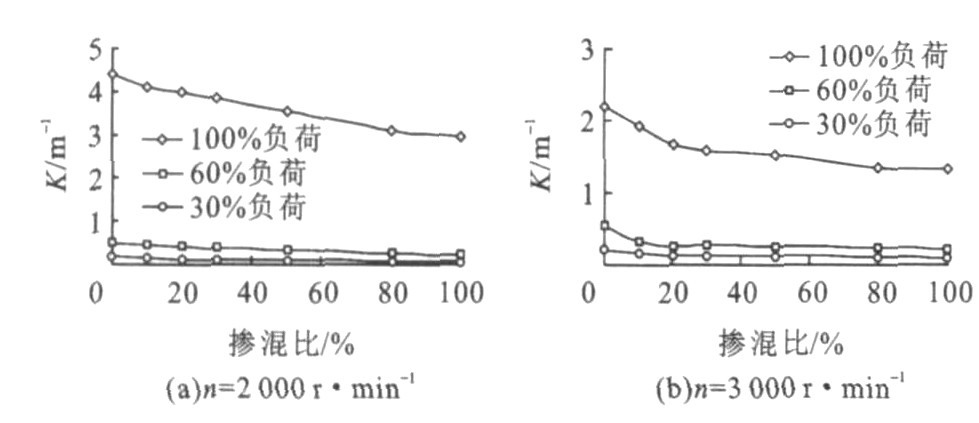Performances and emissions of a supercharged diesel engine fuelled with biodiesel
-
摘要: 为了在柴油发动机上优化生物柴油的应用, 利用发动机台架试验, 对比分析了不同掺混比生物柴油对增压直喷柴油机排放、燃料经济性和动力性的影响, 在不同转速和负荷下, 研究了发动机的碳烟、NOx、CO与HC排放及有效能量消耗率和功率。试验结果表明: 与柴油相比, 燃用B10、B20、B30、B50、B80和B100生物柴油的发动机碳烟排放平均降低了34.69%, NOx排放平均增加了25.01%, HC排放平均降低了33.05%, CO排放在满负荷下平均增加了11.13%;虽然有效燃料消耗率有所增大, 但有效能量消耗率平均降低了2.18%;功率平均增加了5.34%;生物柴油碳烟排放降低的百分比较NOx排放增加的百分比分别提高了7.01%、15.37%、14.17%、10.45%、6.73%和4.39%, 因此, B20掺混比最佳。Abstract: In order to optimize the application of biodiesel for diesel engine, the emissions, fuel economies and power performances of biodiesels with different blend ratios were compared and analyzed by bench tests of a supercharged direct injection(DI)diesel engine, the exhaust emissions of smoke, NOx, CO and HC, effective energy consumption rate and power were investigated under different engine loads and speeds.Experiment result shows that compared with diesel fuel, B10, B20, B30, B50, B80 and B100 blends have, on average, a reduction of 34.69% for smoke emission, an increase of 25.01% for NOx emission, a reduction of 33.05% for HC emission, an increase of 11.13% for CO emission at full load, a reduction of 2.18% for effective energy consumption rate although effective fuel consumption rate is increased, an increase of 5.34% for power, the decreased percentages for smoke emission are 7.01%, 15.37%, 14.17%, 10.45%, 6.73% and 4.39% higher than the increased percentages for NOx emission respectively, so the blend ratio of B20 is optimum.
-
Key words:
- automobile engineering /
- supercharged diesel engine /
- biodiesel /
- blend ratio /
- performance /
- emission
-
表 1 燃料特性对比
Table 1. Comparison of fuel properties
项目 脂肪酸甲酯 0#柴油 常态 液态 液态 20 ℃时密度/(g·mL-1) 0.875 0.834 冷滤点/℃ 1 2 凝点/℃ -0.5 0.0 闭口闪点/℃ 140 60 运动粘度/(mm2·s-1) 4~6 2~4 硫含量质量比/% < 0.001 < 0.200 氧含量体积比/% 10 0 理论质量空燃比 12.5 14.5 质量低热值/(MJ·kg-1) 36.94 42.77 十六烷值 ≥56 ≥49 表 2 混合液特性
Table 2. Blend fuel properties
项目 B0 B10 B20 B30 B50 B80 B100 质量低热值/(MJ·kg-1) 42.77 42.19 41.60 41.02 39.86 38.11 36.94 20 ℃时密度/(g·mL-1) 0.834 0.838 0.842 0.846 0.854 0.866 0.875 -
[1] 边耀璋. 汽车新能源技术[M]. 北京: 人民交通出版社, 2003. [2] Bari S, Yu C W, Lim T H. Effect of fuel injection timing with waste cooking oil as a fuel in a direct injection diesel engine[J]. Journal of Automobile Engineering, 2004, 218(1): 93-104. [3] Tsolakis A, Megaritis A. Exhaust gas assisted reforming of rapeseed methyl ester for reduced exhaust emissions of CI engines[J]. Biomass and Bioenergy, 2004, 27(5): 493-505. [4] 孙平, 江清阳, 袁银南. 生物柴油对能源和环境影响分析[J]. 农业工程学报, 2003, 19(1): 187-191.Sun Ping, Jiang Qing-yang, Yuan Yin-nan. Effect of biodiesel on energy sources and surroundings[J]. Journal of Agriculture Engineering, 2003, 19(1): 187-191. (in Chinese) [5] Sukumar P, Vedaraman N, Sankaranarayanan G, et al. Performance and emission study of mahua oil(madhuca indicaoil)ethyl ester in a 4-stroke natural aspirated direct injection diesel engine[J]. Renewable Energy, 2005, 30(8): 1269-1278. [6] Usta N, Oztürk E, Can O, et al. Combustion of biodiesel fuel produced from hazelnut soapstock/waste sunflower oil mixture in a diesel engine[J]. Energy Conversion and Management, 2005, 46(5): 741-755. [7] Mustafa C. Production of biodiesel fromfeedstocks with high free fatty acids andits effect on diesel engine performance and emissions[D]. Ames: Iowa State University, 2001. [8] 司利增, 边耀璋, 蔡永江. 柴油机燃用生物柴油的特性[J]. 长安大学学报: 自然科学版, 2006, 26(5): 83-85.Si Li-zeng, Bian Yao-zhang, Cai Yong-jiang. Performances of diesel engine fueled with biodiesel[J]. Journal of Chang'an University: Natural Science Edition, 2006, 26(5): 83-85. (in Chinese) [9] 祁东辉, 刘圣华, 李晖, 等. 电喷汽油机燃用甲醇-汽油混合燃料的性能[J]. 交通运输工程学报, 2006, 6(2): 43-46.Qi Dong-hui, Liu Sheng-hua, Li Hui, et al. Performances of electronic fuel injectionfueled with methanol-gasoline blended engine fuel[J]. Journal of Traffic and Transportation Engineering, 2006, 6(2): 43-46. (in Chinese) [10] 申福林, 张勇, 郭金刚. 汽车燃油空气加热器燃烧排放控制研究[J]. 中国公路学报, 2005, 18(4): 115-118.Shen Fu-lin, Zhang Yong, Guo Jin-gang. Research on emission control of vehicle fuel-fired air heater[J]. China Journal of Highway and Transport, 2005, 18(4): 115-118. (in Chinese) -





 下载:
下载:








